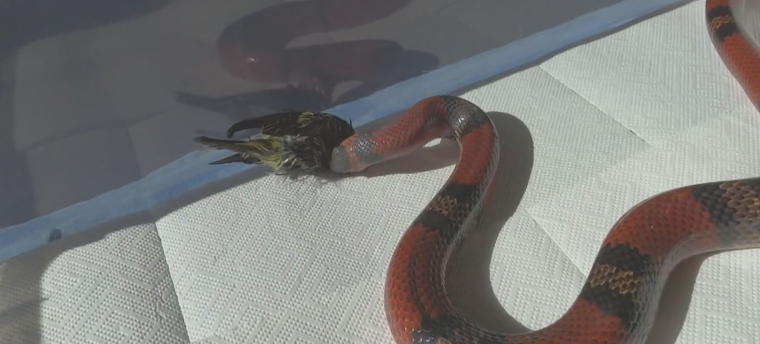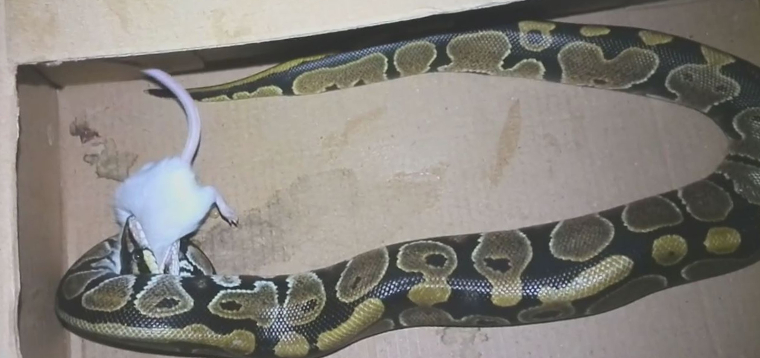-
info@aaanimalcontrol.com
Call us for help in your town
Humane Wildlife Education
Do snakes eat birds?
Need snake removal in your hometown? We service over 500 USA locations! Click here to hire us in your town and check prices- updated for year 2020.
Snakes are carnivores. This means that, unlike humans and scavengers, they will only eat animals — meat produce. They can't survive on a tasty treat of leaves, berries, seeds, or nuts. They MUST eat mean — other animals — in order to survive. There are reported to be over 2,700 species of snake found across the globe, with more being found all the time. Not one of these 2,700 species are vegetarian snakes.

Different species of snake will eat different things, adapting to the food that is readily available around it in many cases. Larger snakes will also go after the larger prey. Snakes know their own size and will usually not hunt after something they won't be able to overcome. It uses up a lot of energy to essentially chase down a prey animal and then fight it with the intentions of killing or overpowering it, only to fail. That isn't energy that these creatures can afford to waste, especially when food comes along scarcely. This is often the case for many snakes.
If snakes come across a bird that is small enough to overcome, they will eat it. They will also prey on the eggs in bird nests. These provide a very easy snack. Eggs don't fight back, can't scurry off, and there are usually more than one egg in the nest. When you think about it, a nest full of eggs is a little bit like a bag of potato chips to a snake.
The kind of snake that eats birds are smaller ones. Larger and more dangerous snakes, such as larger-bodies snakes and venomous snakes, will hunt after larger prey because they have the tools to facilitate it. Smaller snake species, such as those that you would find across the United States, do not have the tools to deal with a much larger animal, so smaller birds, eggs in a nest, chickens, etc. provide the perfect dish.
How do snakes eat?
Need snake removal in your hometown? We service over 500 USA locations! Click here to hire us in your town and check prices- updated for year 2020.
All snakes eat other animals — they are carnivorous. Despite catching animals, mostly live prey, they do not have teeth like other carnivores have teeth. They don't chew their food at all. They swallow the entire thing, in one go, and the food digests over a period of time once the snake has managed to fit the entire thing in. How the snake overpowers its prey will depend on the species.

Venomous snakes will clamp down on their prey, administering a toxin venom that is designed to paralyze the victim, or perhaps even to kill it and start breaking down the biological matter. Other snakes, usually non-venomous, will wrap their entire bodies around the prey, constricting it (hence the name: boa constrictor) and causing suffocation. When the prey has become overpowered or has died, the snake will then proceed to put the entire thing in its mouth. How it does this is nothing short of innovative.
Snakes have a skull and jaw, but the jaw on a snake is built differently. They have the ability to open it up both up and down, as well as side to side. Humans only have the up and down ability and are, therefore, limited to the size of food that they can fit in the mouth. Snakes can consume prey that is much bigger than they are. The jaw is able to split open so that it ends up being much wider and larger than the actual snake's body, and you can often see the bulge in the middle of the stomach where the animal sits until it has been broken down by the stomach acid and powerful muscles.
The digestion period of the food is actually dependent on the temperature of the snake's body. Larger meal items will generally take a week or so to fully digest, and the snake will be slow and sluggish during this time. The energy consumed trying to digest the food doesn't leave much for slithering around and catching more prey. During this sluggish time, the snake is also more vulnerable and, therefore, more likely to come under attacks from predators sensing that vulnerability. The warmer the snake's body is, the faster the food will digest, so in some cases, a large meal can be fully digested in as little as three days. Colder snakes, in colder temperatures, will take longer — closer to a week.
Snake prey will change from species to species, and it will also depend on the habitat in which the snake lives. Those that live closer to water may eat crustaceans, frogs, toads, newts, etc. Smaller snakes will opt for small prey items, starting with tiny mice and eggs in bird nests. Larger snakes will move on to birds, chickens, chipmunks, rats, and maybe even slightly larger wild critters. The largest snake species — those that have a body big enough and strong enough to overcome — will even hunt and attempt to overpower pigs, deer, monkeys, crocodiles, and more, dependent on where in the world they are.
For more information, you may want to click on one of these guides that I wrote:
How much does snake removal cost? - get the lowdown on prices.
How to get rid of snakes - my main snake removal info guide.
Example snake trapping photographs - get do-it-yourself ideas.
Snake job blog - learn from great examples of snake jobs I've done.


















